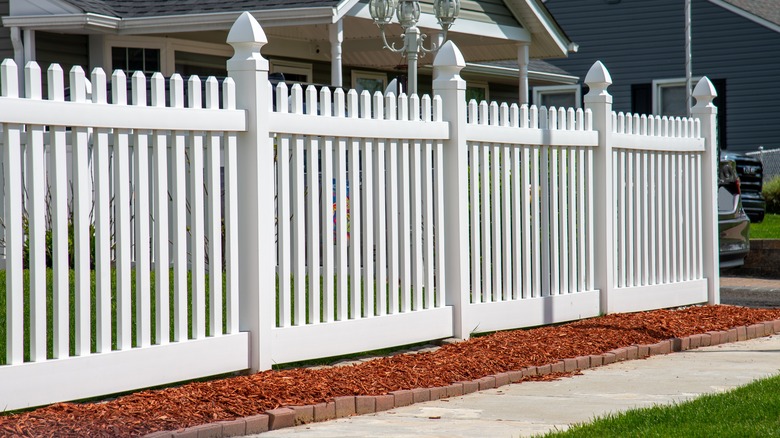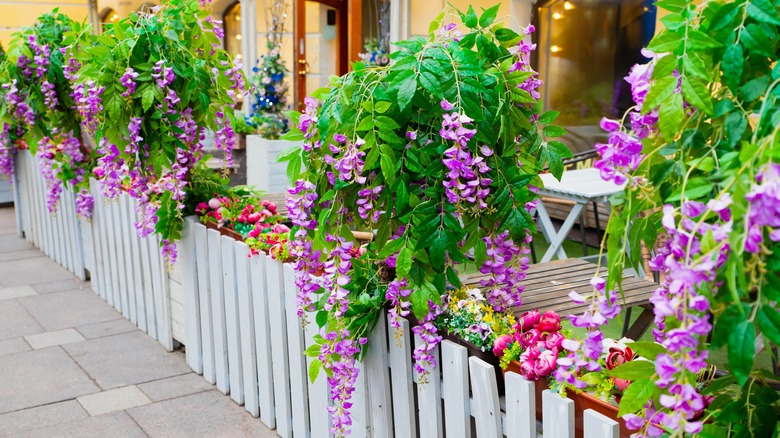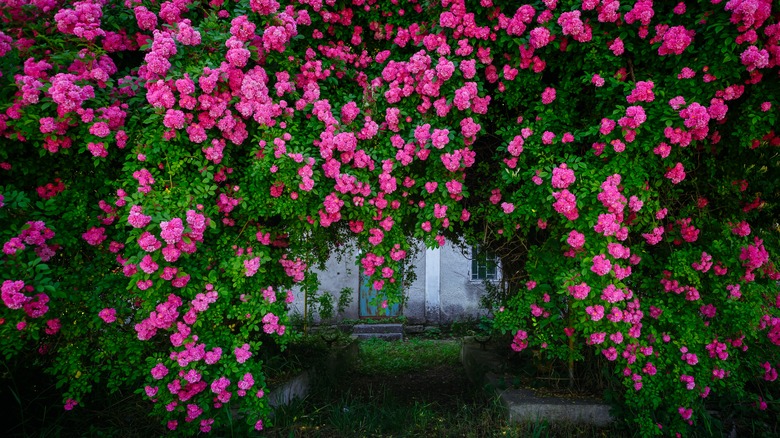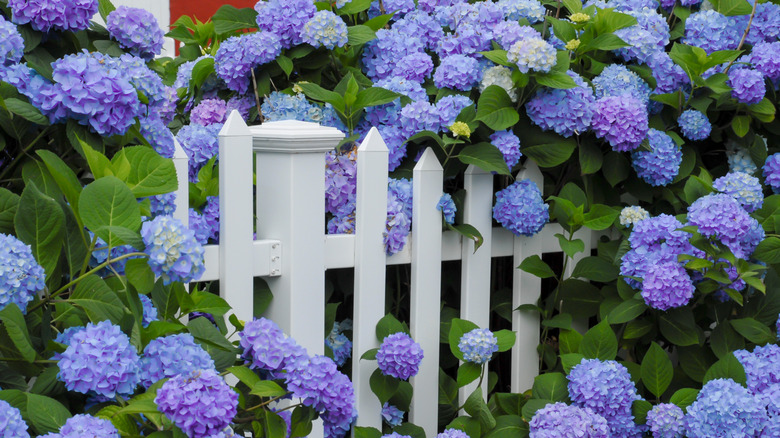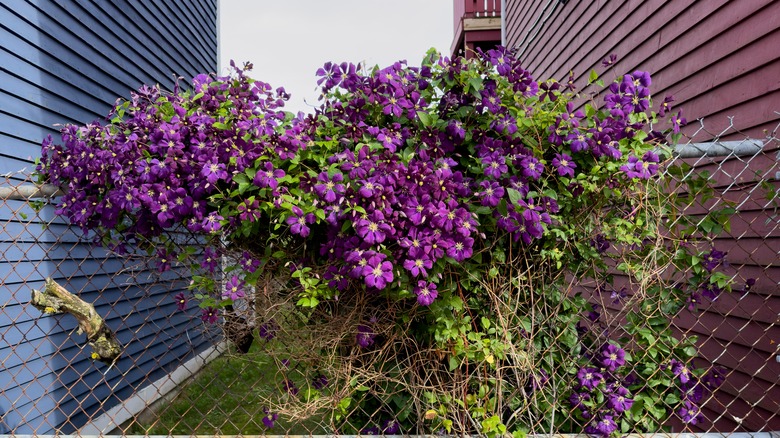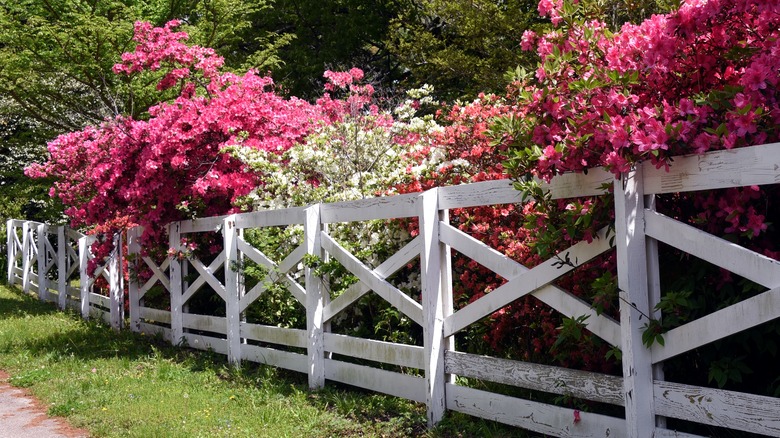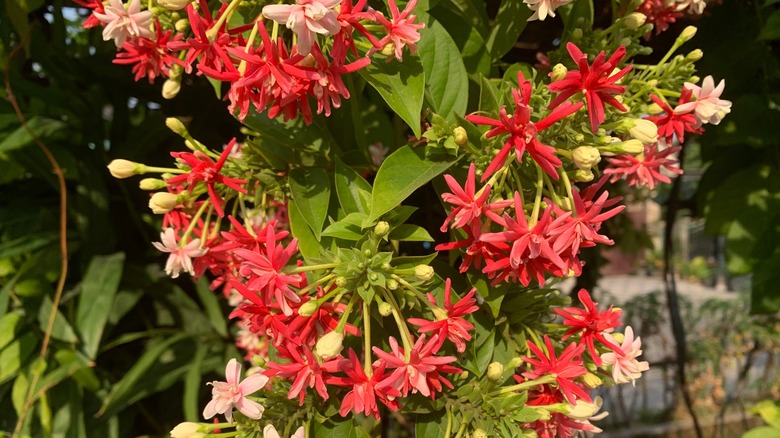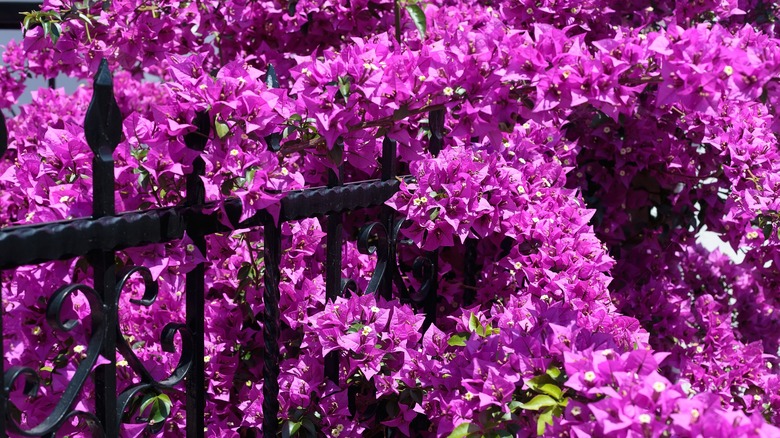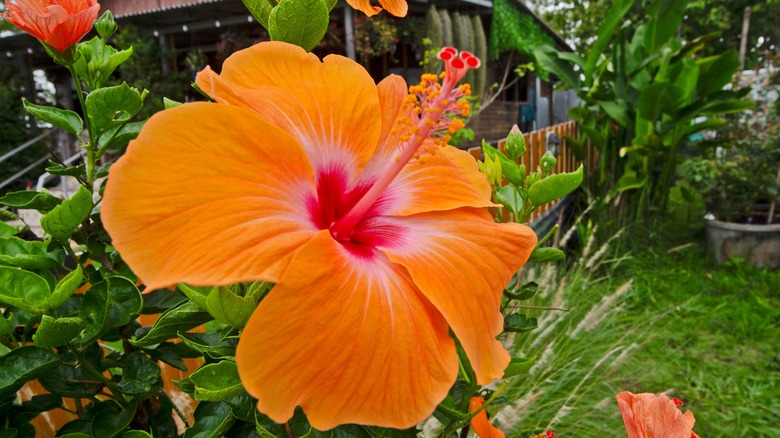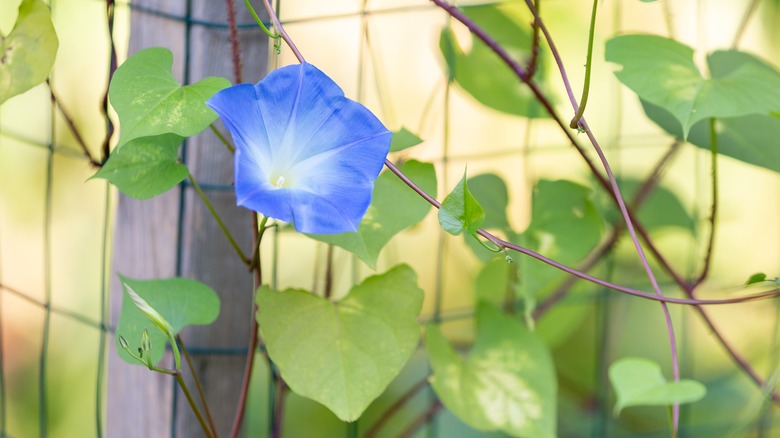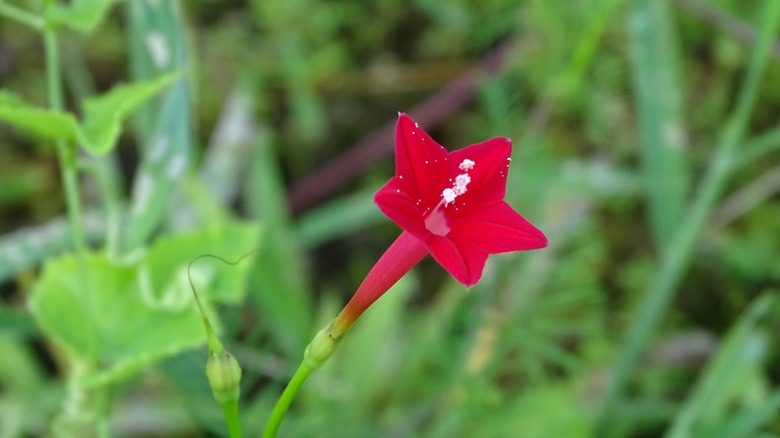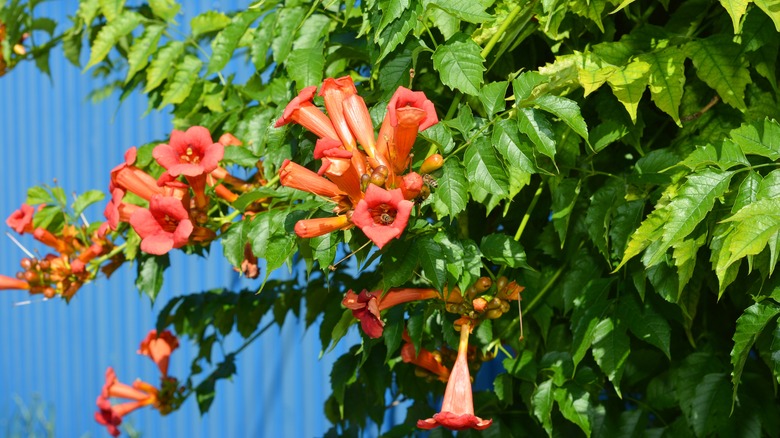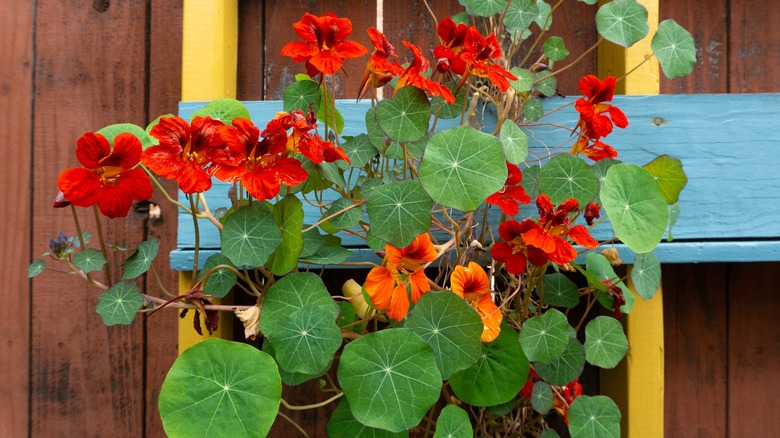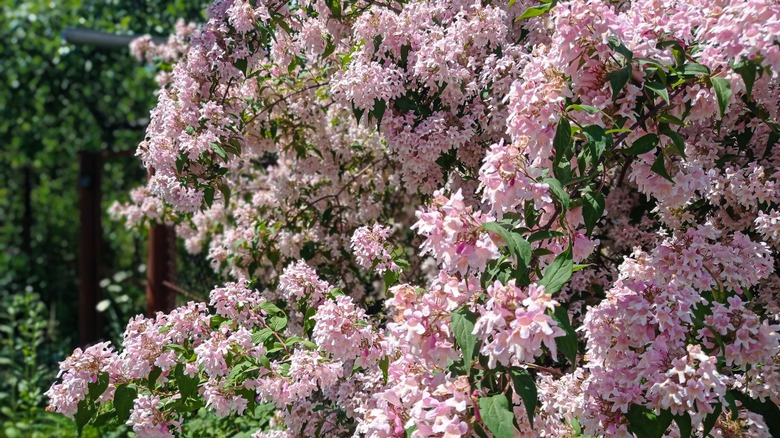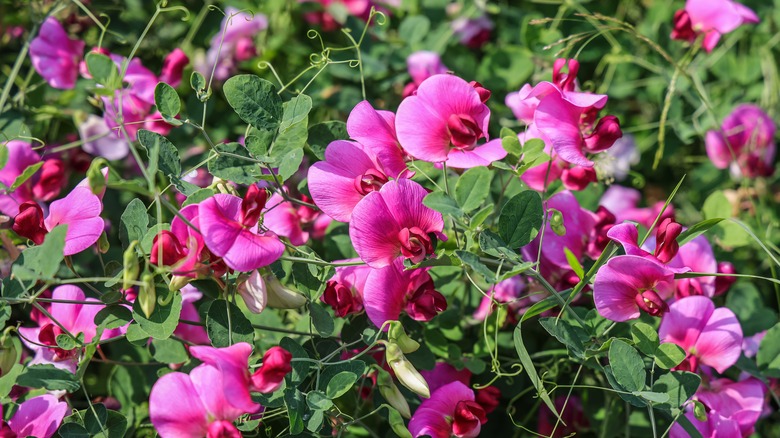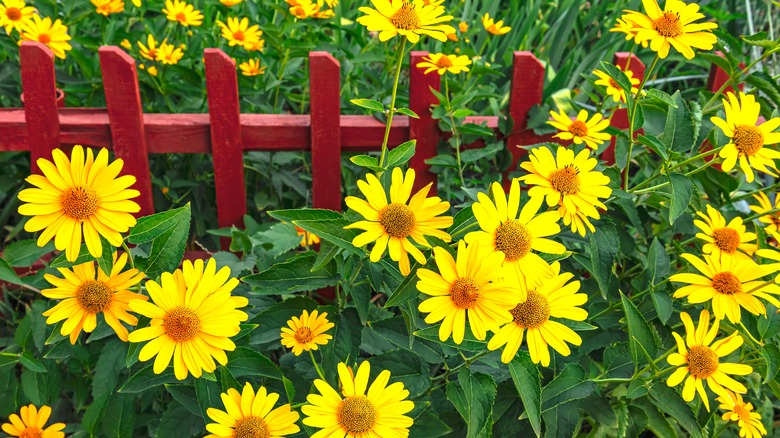16 Of The Most Stunning Plants To Grow Along Your Pre-Existing Fence
Whether or not good fences actually make good neighbors probably depends a lot on the fence itself. More certain is that a good flowering vine can add beauty and character to just about any fence. Of course, they don't have to be vines at all; plants of any habit can transform a fence or wall. However, some types of plants will make unusually good partners for your existing fence. Vining, climbing, and creeping plants are naturals, of course.
These plants make the fence their own, and they make it better. Some tend to sort of occupy a fence, poking blooms through it as if unable to be restrained. Others simply have a shape, foliage, or flowers that contrast or complement certain types of walls. Let's take a look at some beloved options that can pair well with any fence, from the predictable options like jasmine or bougainvillea to less common choices like blackberry and heliopsis.
1. Wisteria
You may already have a few trees that become a riot of wisteria in early spring or late summer, depending on the species. But wisteria is nowhere as comfortable as on a fence or, better yet, reaching down to a fence from an arbor. And growing here rather than at the tree line, your friends might even believe you planted it yourself. But keep in mind that native and Japanese wisteria can destroy paint and overwhelm a flimsy fence. You should know that Chinese wisteria, like other invasive vines, has a habit of escaping cultivation, so plant with care.
2. Climbing roses
English rose breeder extraordinaire David Austin has developed so many extraordinary climbing roses, it's easy to think of his creations -– from apricot Lady of Shalott to vibrant pink Gertrude Jekyll –- as the height of fence and arbor roses. But don't forget the classic climbing roses such as the Sweetheart Rose, which defines the wild, scattery elegance you can achieve with a climbing rose and just about any old fence. And if you're determined to cover a tall fence, try the New Dawn variety, which reaches heights of 15 feet.
3. Hydrangea
If you're looking for drama, you can't do much better than climbing hydrangea. These vines can grow 80 feet long, so you can get a lot of fence coverage out of them. But they are slow-growing and prefer cool temperatures. If any of that doesn't resonate with your needs, shrub varieties like Hydrangea paniculata are so fence-like that they don't really even need a fence. Panicle hydrangeas grow up to 15 feet tall. They are deciduous, so if your goal is privacy, consider planting some evergreens beside the hydrangeas or on the other side of the fence.
4. Clematis
With a palette covering the palest to the richest colors and growth habits ranging from a scattered patrol of blooms to a march or, occasionally, an overwhelming brigade of flowers, clematis can be just about anything you want it to be. Clematis is at home on any fence or wall because the structure usually simply disappears somewhere behind the blooms, whether there are three or 300. Combine it with forsythia for a wall of continuous color. The best are blooms with contrasting colors, but there are also varieties with subtler shades, which are equally wonderful.
5. Azalea
Whether it's small azaleas in front of a fence or enormous azalea bushes behind it, pairing azaleas with picket or iron fences is a classic. Not all fences are covered, of course, and azaleas prefer a bit of shade. But if you have a fence in a shady area, and as long as whoever set your fence posts didn't go crazy with the concrete (which makes the soil more alkaline than azaleas are comfortable with), you should consider planting azaleas. Also consider adding companion plants that go well with azaleas.
6. Jasmine
You might grow jasmine for its scent. Why wouldn't you? But you might also grow it for the blooms, whether simple white stars or the doubles that are so fluffy you have a perverse urge to squeeze one in your fist. But when it comes to beautifying a fence, it's surely the foliage you care about. The best might be the varieties with swirls of darker green, more elongated leaves that blooms seem to float above. Common jasmine, also known as poet's jasmine, attracts butterflies, hummingbirds, and, apparently, poets.
7. Bougainvillea
If you live in hardiness zone 10 or 11, bougainvillea is consolation enough. There, running wild over any fence or wall as it sees fit, this vine earns its keep by impressing your neighbors, relieving you of fence maintenance, and requiring little care along the way. And you get what many consider to be the most beautiful flowering vine in the world. Bougainvillea demands full sun, at least if you want the payoff of blooms ... and you do. If you live in areas where it can become invasive, you can grow it in containers.
8. Hibiscus
Like panicle hydrangeas, hibiscus can reach 15 feet in height, and it can do it reasonably quickly depending on the variety, with some adding as much as two feet of growth per year. Its shrub-like habit makes it a great hedge, but it also likes to be sheltered from wind. So while many fences benefit aesthetically from ornamental plants, the hibiscus benefits from the fence. Hibiscus flowers constantly from summer through early fall. Consider Hibiscus acetosella if you want a hibiscus with foliage as profoundly colored as its day-long blooms.
9. Morning glories
Because they can be grown in a sidewalk crack and seem to do better with less attention, it's sometimes tempting to use a phrase like "the humble morning glory." Ridiculous. Look again, and the impulse will pass away instantly. Morning glories are dramatic, sublime blooms. Each vine seems to produce tons of seeds that find their way to everyone eventually. But keep in mind that we're talking about the morning glory genus Ipomoea and not the invasive wild morning glory (Convolvulus arvensis)... though there are certainly worse-looking plants to be invaded by.
10. Cypress vine
Cypress vine, sometimes called cardinal vine or hummingbird vine, is another Ipomoea plant that is less showy than morning glories. Or perhaps it's correct to say that it's less dramatic, because there's plenty of show in the combination of the feathery, hemlock- or dill-like foliage and the brilliant little red star blooms that float among the vines. You don't have to invest much work for the payoff, since cypress vine is very tolerant of heat and drought, and it grows fast enough to cover a fence in no time.
11. Trumpet vine
The near-instant gratification of morning glory and cypress vine might spoil you, making all the more painful your wait when you decide to plant a trumpet vine and wait three to five years for its first blooms. It's also invasive in some areas and mildly toxic, so you might be asking yourself why one would bother. But when you finally see it bloom at the end of four years, you won't question your decision. It grows vigorously, overrunning an arbor or fence, eventually cascading in endless clusters of trumpet-shaped blooms.
12. Nasturtium
Nasturtiums, with their pretty orange-red flowers, are a little bit of everything. The lily pad-like foliage makes you feel like you can reach through it and grab a handful of pond water. They're annuals in most places but can be perennial in zones 9 through 11. Their flowers are edible and sweet, with a peppery taste that deer and rabbits find objectionable. Fermented nasturtium buds make a passable, or even superior, alternative to capers. And on top of all that, nasturtiums can turn the most dilapidated privacy fence or mean chain link into a thing of beauty.
13. Blackberry
If you'd like your perimeter to have fairytale whimsy, and a moat or battlement is out of the question, consider the next most-challenging option: a blackberry vine. For all the pain of managing this noxious weed, you'll get paid back in spades. In early spring you might occasionally forget what you're looking at and mistake its blooms for the prettiest little single rose. Then come the fruit, in red and then black, somehow rivaling even the blooms. Then go the fruit, into a salad or preserves or directly into your mouth on a hot summer day.
14. Beauty bush
If you've spent a few seasons around a beauty bush but weren't familiar with it, you probably remember that moment when you caught a glimpse of the fireworks-like explosion of white or pink flowers, arching away from the central trunk with all the energy and a bit more jazz than forsythia. They can get quite large and are at home intermingled with just about any sort of fence. A compact variety like Jolene Jolene will sit prettily in front of your fence with its gorgeous yellow and pink blooms.
15. Sweet Pea
The sweet pea is a lie, and possibly a trap, but it might be worth it. The genus name of ornamental sweet peas, Lathyrus, is also the name of the condition you get when they've poisoned you, so right out of the gate it's not the best pea on the block. Being a legume, they have pretty little flowers that have a regal quality offset by curly tendrils and pods – somewhere short of spectacular, but not by much. The vining sweet pea looks great on a fence ... if you dare!
16. Heliopsis
Dubbed "false sunflower" by someone who didn't properly appreciate it, Heliopsis is an herbaceous perennial with single or reflexed ray petals in yellows and oranges, running nearly all the way to red. The flowers grow 3 to 5 feet high amid toothed foliage that can be variegated and is generally very attractive. What does this have to do with fences? Heliopsis makes an amazing companion to any fence, as its lovely leaves and bright flowers will complement any type — or distract from it altogether if that's what you're going for.
